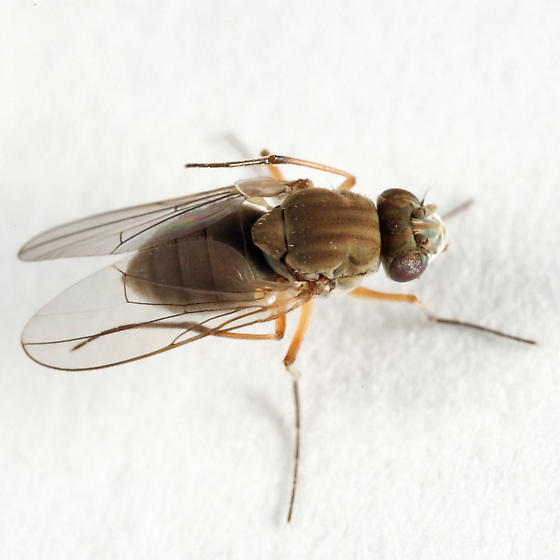Description
Potentially Misidentified Species - Brachydeutera argentata is native and widespread in Eastern North America, MI-ME to TX-FL (Mathis and Steiner 1986).
Taxonomy
| Kingdom | Phylum | Class | Order | Family | Genus |
|---|---|---|---|---|---|
| Animalia | Hexapoda | Insecta | Diptera | Ephydridae | Brachydeutera |
Synonyms
Invasion History
Chesapeake Bay Status
| First Record | Population | Range | Introduction | Residency | Source Region | Native Region | Vectors |
|---|---|---|---|---|---|---|---|
| 1984 | Established | Unknown | Introduced | Regular Resident | East Asia | East Asia | Shipping(unspecified), Ornamental(Aquatic Plant) |
History of Spread
The shore fly Brachydeutera longipes is native to Asia, where it ranges from Iraq to Japan, and south to Sri Lanka (Mathis and Steiner 1986; Mathis and Zatwarnicki 1995). Its first collection in North America occured in 1983, in Tatnall County, GA, near the Altamaha River. Subsequently, in 1984, it was found in Silver Spring (Montgomery County) MD and Wittman MD (Talbot County), near Harris Creek on the Eastern Shore of Chesapeake Bay (Mathis and Steiner 1986). All of these captures were of adult flies at black lights, but they imply that the aquatic larvae were present in nearby water. Later, B. longipes was captured in Ontario, Mexico, and Venezuela (Mathis and Zatwarnicki 1995). Populations of B. longipes are now established in the Chesapeake Bay region, and elsewhere in North America (Mathis 2000). Subsequently, it was collected in Barbados, the Cayman Islands, Grenada, Jamaica, Bomincan Republic, Puerto Rico, Mexico (Veracruz), Honduras and Bolivia (Mathis and Winkler 2003).
History References - Mathis 2000; Mathis and Steiner 1986; Mathis and Winkler 2003; Mathis and Zatwarnicki 1995
Invasion Comments
Residency - In North America, adults of Brachydeutera longipes have been captured primarily in terrestrial locations, but usually not far from nontidal rivers. One capture in MD was near a brackish tidal marsh (Mathis and Steiner 1986). Around Bangalore, India, an inland city, adults and larvae are found near stagnant freshwaters (Venkatesh 1976). In the Hooghly estuary, India, adults and larvae of this fly were collected year-round at 0-40 ppt (Ray and Choudhury 1989). Until more data on its breeding in the Chesapeake region is available, we will consider this species a regular resident.
Likely Vectors into Chesapeake Bay, North America - The larvae of this fly inhabit shallow and stagnant fresh waters, frequently with dense aquatic vegetation. (Venkatesh 1976; Venkatesh et al. 1977). Thus, transport with aquatic plants seems the likeliest vector (Mathis and Steiner 1986). However, transport of flies with cargo or by other means on ships is also possible.
Ecology
Environmental Tolerances
| For Survival | For Reproduction | |||
|---|---|---|---|---|
| Minimum | Maximum | Minimum | Maximum | |
| Temperature (ºC) | 40.0 | 40.0 | ||
| Salinity (‰) | 0.0 | 40.0 | 0.0 | 40.0 |
| Oxygen | ||||
| pH | 7.7000000000 | 8.5000000000 | ||
| Salinity Range | fresh-meso |
Age and Growth
| Male | Female | |
|---|---|---|
| Minimum Adult Size (mm) | 2.1 | 2.1 |
| Typical Adult Size (mm) | 2.5 | 2.5 |
| Maximum Adult Size (mm) | 3.2 | 3.2 |
| Maximum Longevity (yrs) | ||
| Typical Longevity (yrs |
Reproduction
| Start | Peak | End | |
|---|---|---|---|
| Reproductive Season | |||
| Typical Number of Young Per Reproductive Event |
|||
| Sexuality Mode(s) | |||
| Mode(s) of Asexual Reproduction |
|||
| Fertilization Type(s) | |||
| More than One Reproduction Event per Year |
|||
| Reproductive Startegy | |||
| Egg/Seed Form |
Impacts
Economic Impacts in Chesapeake Bay
Brachydeutera longipes, at this time, is so rare in the Chesapeake region that it has no detectable economic impacts.
Economic Impacts Outside of Chesapeake Bay
Brachydeutera longipes in its native India, reaches densities so great that its larvae may clog water pipes (Venkatesh 1976). However, impacts in its introduced range in North America are unknown (Mathis and Steiner 1986).
References- Mathis and Steiner 1986; Venkatesh 1976
Ecological Impacts on Chesapeake Native Species
The abundance of the shore fly Brachydeutera longipes in North America and the Chesapeake Bay region is unknown. This fly is probably too rare to have significant ecological impacts on native biota.
Ecological Impacts on Other Chesapeake Non-Native Species
Impacts of the shore fly Brachydeutera longipes on other introduced biota are unknown in the Chesapeake Bay region.
References
Mathis, Wayne N.; Steiner, Warren E., Jr. (1986) An adventive species of Brachydeutera Loew in North America (Diptera: Ephydridae), Journal of the New York Entomological Society 94: 56-61Mathis, Wayne N.; Zatwarnicki, Tadeusz (1995) World Catalog of Shore Flies, Memoirs on Entomology, International 4: 1-423
Ray, S.; Choudhury, A. (1989) Occurrence and abundance of benthic dipterans in a tidal creek of Hooghly estuary, Sagar Island, India., Tropical Ecology 30: 303-308
Simpson, Karl W. (1976) Marine Insects, In: (Eds.) . , Amsterdam. Pp. 465-495
Venkatesh, M. G (1976) Some observations on the biology of Brachydeutera longipes Hendel (Insecta: Diptera; Ephydridae), Science and Culture 42: 175-176
Venkatesh, M. G.; Chenna Basavanna, G. P.; Parasarthy, M. D. (1978) Population ecology of the shore-fly Brachydeutera longipes Hendel in Bangalore (Karankataka)., Bulletin of Entomology 19: 171-178
Venkatesh, M. G.; Parasarthy, M. D.; Chenna Basavanna, G. P. (1977) Food and feeding behaviour of the shore-fly maggot, Brachydeutera longipes Hendel (Diptera: Ephydridae), Indian Journal of Behaviour 1: 10-13
Wirth, Willis W.; Mathis, Wayne N.; Vockeroth, J. R. (1987) Family Ephydridae., 2 , Ottawa. Pp. 1027-1047
